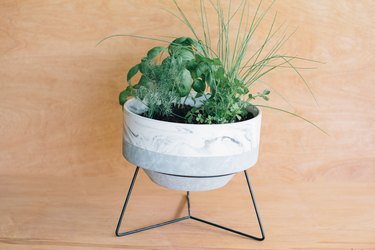
At this time of year, many of our outdoor gardens are frozen or covered in snow. (Or, perhaps your garden has simply been neglected as of late?) Winter is the perfect time to start an indoor herb garden. Here are six picks for the best herbs to grow in your home, plus helpful need-to-know gardening tips.
Italian Flat-Leaf Parsley
Video of the Day
The curly kind is prettier, one might argue, but any cook is going to prefer flat-leaf parsley that offer a real flavor punch. To grow this kind of parsley on your kitchen windowsill, plant seeds after soaking them in warm water for a few hours. Select a deep pot with good drainage and give it good sunlight. This is the herb that will provide the "pow" you need in tabbouleh, and it serves as a key flavoring for many Mediterranean dishes.
Video of the Day
Tip for indoor herbs: Most herbs need quite a bit of sunlight to thrive, and parsley is one of them. Pick a window facing south or west. It never hurts to use a grow-light in winter to supplement the sun. These days, you can just buy a grow bulb that fits into a regular light, so it doesn't have to be a big deal. If you have little or no direct sun, you'll need to get full-spectrum lighting and place it close (3 to 6 inches) to the top of the plants.
Garlic Chive
Why go for regular, onion-flavored chives when you can grow garlic chives just as easily? Fresh chives are wonderful chopped up and sprinkled in soups, salad, and potato dishes, importing the flavor and smell of garlic. The chives can also be used for infusing oils. And they are among the easiest herbs to grow inside. You can start them from transplants, but chives also grow happily from seeds scattered over soil in a six-inch pot. Cover then lightly and keep the soil moist. When you snip a bit to use in cooking, leave at least two inches to allow the plant to regrow.
Tips for indoor herbs: Few if any potted herbs appreciate constantly wet soil and most require excellent drainage to thrive. This means that you'll want to select well-draining potting soil but also containers with holes in the bottom. Skip the cute pot with no holes in the bottom; yes, it prevents leaks onto your windowsill, but it doesn't allow excess water to drain from the pot. Ideally, use clay pots with saucers under them and don't forget to dump out the water accumulating in the saucer.
Peppermint or Spearmint
Mint comes from Asia and the Mediterranean region, where it came to symbolize hospitality and friendship. All mint plants are ready, willing, and able thrive — to such an extent that they can overwhelm a veggie garden outdoors. Planted inside, they will grow readily from seed or by dividing an existing plant. Peppermint and spearmint are the most common varieties, with the former a favorite for tea and spearmint preferred for cooking. But there are lots of types of mint to choose from including apple mint, pineapple mint, orange mint, and even chocolate mint. If growing from seed, plant 1/4 inch under the soil surface.
Tip for indoor herbs: Soil counts, especially when you are growing plants in containers. Don't go for the cheapest bag on the shelf unless it's a brand you know and love that happens to be on sale. Look for something that drains well or mix up your own using two parts potting soil with one-part perlite or sharp sand. Try for a soil pH between six and seven.
Greek or Italian Oregano
Oregano is one of those classic perennial herbs that belong in every herb garden. Add this savory herb to tomato sauces or pizza, as well as meat dishes. Two great picks are Italian oregano, beloved for its sweet fragrance, and a very attractive option with its delicate, light green leaves and compact growth pattern. For a more peppery flavor, opt for Greek oregano, with a robust taste, gray-green leaves and small purple flowers. Related to mint, oregano grows just as easily and rapidly from either an existing plant or from seed. However, oregano needs more fertile soil, so mix in organic compost when you are potting it up.
Tip for indoor herbs: Every plant needs water, but not every plant needs the same amount of water. Some — like mint and oregano — prefer to get a drink only when the soil has dried out. Others, like basil, prefers a bit more water. Generally, indoor herbs do not require much water and you are more likely to kill them with too much than too little.
Genovese Basil
There are lots of types of basil out there, but the classic, traditional Italian basil used in pesto is Genovese, so it is a good first choice. Basil needs more light and a bit more water than the other herbs, and it only lives a short time before going woody. But given its reputation and popularity, it deserves a spot in your winter herb lineup. Grow basil easily from seed. Planted shallowly and kept warm and light, basil seeds germinate in five to 10 days. Basil is picky about water and will rot if given too much, but it may die if the soil dries out. This is one herb that likes a little fertilizer, so use something water soluble every few weeks.
Tip for indoor herbs: You may not like to gather your roses or tulips for an indoor bouquet or harvest your spinach when it is tiny, but do not hesitate to take snippets from your herb garden regularly. Once an herb plant is six inches tall, trim off some tips every few weeks. Pruning them back — whether to cook with or not — helps them grow fuller and bushier.